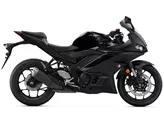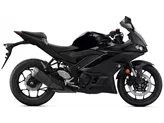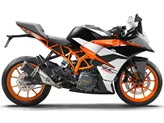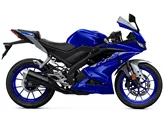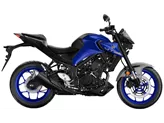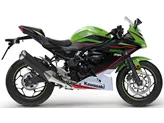Yamaha YZF-R3 2019 vs. Kawasaki Ninja 400 2018

Yamaha YZF-R3 2019

Kawasaki Ninja 400 2018
Overview - Yamaha YZF-R3 2019 vs Kawasaki Ninja 400 2018
In terms of technical specifications, the Yamaha YZF-R3 2019 has a bore of 68 mm and a stroke of 44.1 mm, while the Kawasaki Ninja 400 2018 has a bore of 70 mm and a stroke of 51.8 mm. The Yamaha YZF-R3 2019 has an engine power of 42 HP and a torque of 29.6 Nm, whereas the Kawasaki Ninja 400 2018 has an engine power of 45 HP and a torque of 38 Nm. Both bikes have a compression ratio of 11.2 and 11.5 respectively.
In terms of engine configuration, both the Yamaha YZF-R3 2019 and the Kawasaki Ninja 400 2018 have 2 cylinders with 4 valves per cylinder. However, the Yamaha YZF-R3 2019 has a displacement of 321 ccm, while the Kawasaki Ninja 400 2018 has a displacement of 399 ccm.
In terms of suspension, the Yamaha YZF-R3 2019 has an upside-down telescopic fork with a diameter of 37 mm for the front suspension, while the Kawasaki Ninja 400 2018 has a telescopic fork with a diameter of 41 mm for the front suspension. Both bikes have a swing arm for the rear suspension.

Yamaha YZF-R3 2019
In terms of chassis, the Yamaha YZF-R3 2019 has a twin tube frame type with a rake of 25 degrees and a trail of 95 mm, while the Kawasaki Ninja 400 2018 has a tubular frame type with a rake of 63 degrees and a trail of 93 mm.
In terms of brakes, both the Yamaha YZF-R3 2019 and the Kawasaki Ninja 400 2018 have a single disk front brake with a diameter of 298 mm and 310 mm respectively.
Both bikes are equipped with ABS as an advanced rider assistance system.

Kawasaki Ninja 400 2018
In terms of dimensions and weights, both the Yamaha YZF-R3 2019 and the Kawasaki Ninja 400 2018 have a front tire width of 110 mm and a front tire diameter of 17 inches. However, the Yamaha YZF-R3 2019 has a rear tire width of 140 mm and a rear tire diameter of 17 inches, while the Kawasaki Ninja 400 2018 has a rear tire width of 150 mm and a rear tire diameter of 17 inches. The Yamaha YZF-R3 2019 has a wheelbase of 1380 mm and a seat height of 780 mm, while the Kawasaki Ninja 400 2018 has a wheelbase of 1370 mm and a seat height of 785 mm. The Yamaha YZF-R3 2019 has a kerb weight (with ABS) of 169 kg and a fuel tank capacity of 14 liters, while the Kawasaki Ninja 400 2018 has a kerb weight (with ABS) of 168 kg and a fuel tank capacity of 14 liters.
In terms of strengths, the Yamaha YZF-R3 2019 has a high-revving engine with sufficient power for everyday use and compact racetracks. It also provides a good basis for racetrack conversions and has stable handling, making it suitable for long distances. On the other hand, the Kawasaki Ninja 400 2018 has a chassis that is suitable for sporty use, with low weight and correspondingly effortless handling. Its engine has smooth response and it offers a relaxed and confidence-enhancing seating position. Additionally, it is equipped with LED headlights.
In terms of weaknesses, the Yamaha YZF-R3 2019 has poor throttle response at low revs and not enough feedback in the brake lever. Some riders may find the knee angle too acute. On the other hand, the Kawasaki Ninja 400 2018 has brake and clutch levers that are not adjustable. Riders over 180cm tall may experience enormously loud wind noise with the original windshield.
Technical Specifications Yamaha YZF-R3 2019 compared to Kawasaki Ninja 400 2018
Pros and Cons in comparison
Pros and Cons in comparison
Yamaha YZF-R3 2019

With the new YZF-R3, Yamaha has taken the very good basis of the first generation and successfully developed it further. It now appears not only visually more mature, but also noticeably more competent at high speeds. When you ride the R3 at the limit, you quickly feel why Yamaha has set up its own Cup on it, as even the standard model gives a safe feeling at high speed. Nevertheless, there is room for improvement, especially in everyday use, when the rough response at low revs and the poor feedback from the brake lever lead to some moments of frustration during the ride.
Kawasaki Ninja 400 2018

In summary, the Ninja 400 could be described as the perfect entry into the supersport world. You can't get more power with A2, the looks suggest much more power, the vehicle is playful to ride, is forgiving in every respect and still allows a really sporty riding style. Those who had legitimate concerns about the lack of power on the various 250 cubic machines now have no more excuses. Ninja 400, it's good to have you!
Price Comparison Avarage Market Price Yamaha YZF-R3 vs Kawasaki Ninja 400
There are a few key differences between a Yamaha YZF-R3 2019 and a Kawasaki Ninja 400 2018. In terms of price, the actual average price of a Kawasaki Ninja 400 2018 is about 9% higher. Compared to Kawasaki Ninja 400 2018 there are less Yamaha YZF-R3 2019 bikes available on the 1000PS.de Marketplace, specifically 4 compared to 10. It takes less time to sell a Yamaha YZF-R3 with 99 days compared to 105 days for a Kawasaki Ninja 400. Since model year 2015 1000PS.de editors have written 11 reviews for the Yamaha YZF-R3 and 9 reviews for the Kawasaki Ninja 400 since model year 2018. The first review for the Yamaha YZF-R3 was published on 17/10/2014 and now has more than 53,600 views. This compares to more than 44,300 views for the first review on Kawasaki Ninja 400 published on 22/11/2017.


